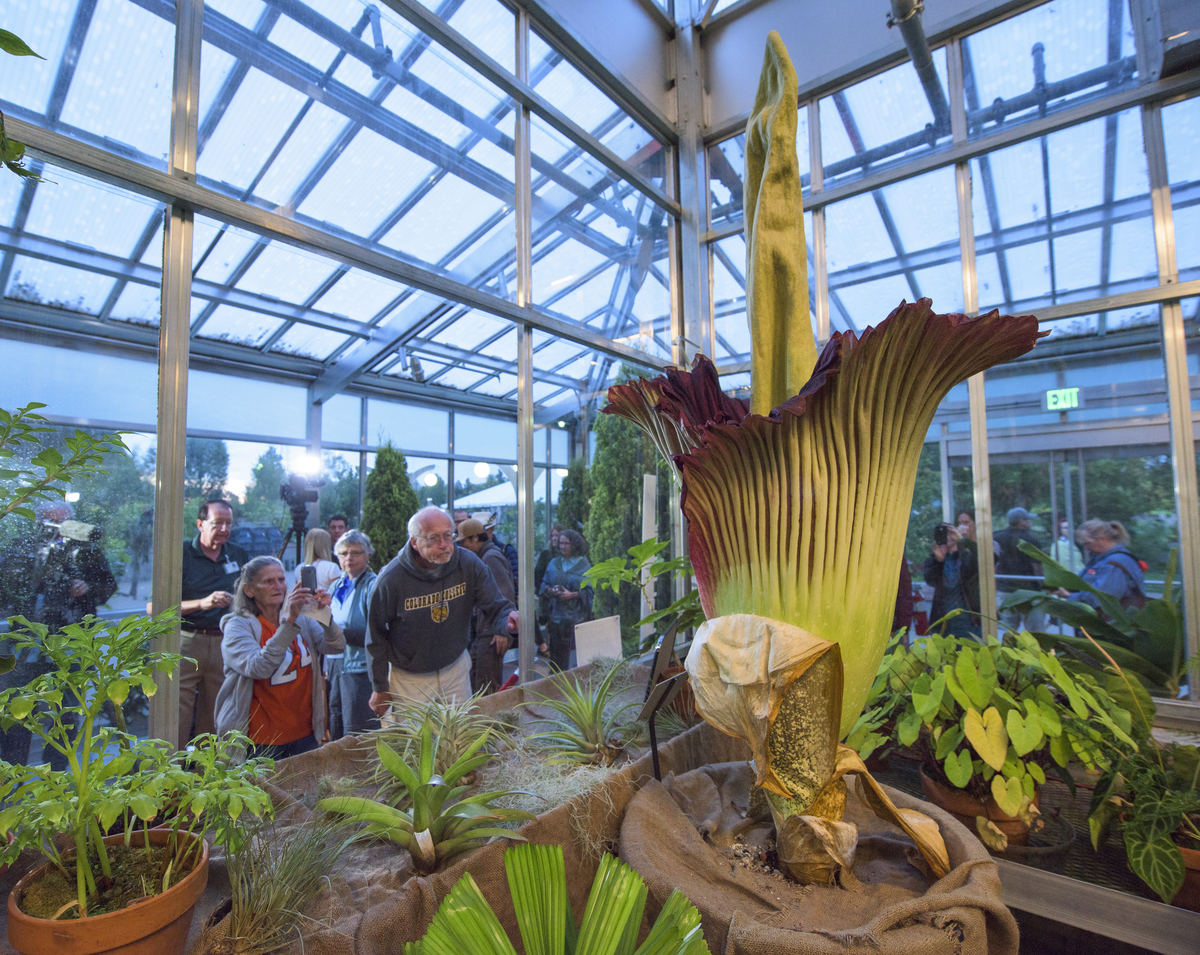Denver's 'Corpse Flower' Really Does Smell Like Rotting Meat

DENVER — From the front of the 3-hour line where thousands of people wait to sniff the first bloom of a giant corpse flower in Colorado, the stench is more like a whiff.
It's the kind of nagging odor that, if it occurred in your kitchen, might make you wonder if there's a terrible surprise lurking at the back of the fridge. This is the smell used by the corpse flower, or titan arum, to lure flies and beetles to its blossom. These insects are the main pollinators for the plant, which is native to Sumatra, Indonesia.
Around the back of the greenhouse here at the Denver Botanic Gardens, the smell is stronger, drawn out by the fans that circulate air through the building. A sharply dressed woman in red leans in close to one of the vents and makes a face. [Watch Live As Denver's Corpse Flower Blooms]
The plant earns its name — the flower does, indeed, smell like a corpse.
First flower
The plant blooming this week at the Denver Botanic Gardens is the first titan arum ever to bloom in the Rocky Mountain region. The Gardens received the plant as a donation back in 2007, said horticulturist Aaron Sedivy; it's now about 13 years old. This is the first time it's ever bloomed.
Corpse plants have a three-stage life cycle. First, they send up a single leaf, which then dies off, leaving a tuber dormant underground. After the dormancy phase, the plant can send up another, bigger leaf, or grow a flower. It often takes 10 to 15 years for the plant to bloom for the first time. That puts the Denver corpse flower right on schedule.
Sign up for the Live Science daily newsletter now
Get the world’s most fascinating discoveries delivered straight to your inbox.
"Around the first of June, we realized that it was not a new leaf emerging," Sedivy told Live Science. "It was definitely a flower bud."
Predicting the date of the bloom was tricky, Sedivy said; there isn't much data on corpse plants, which are rare even in their native habitat in Indonesia.
"We had a growth chart we were comparing it with — just one — and we had a few plants that had near-daily photos of their progression," Sedivy said.
On Tuesday at around 6 p.m., it was clear the bloom was starting to unfurl. The peak bloom probably occurred in the wee hours of Wednesday morning, Sedivy said. The blossom didn't open wide, and horticulturists aren't sure why. It could be because that's simply the shape of this particular plant, or it could be because the plant is young and small. [See Photos of the Denver Corpse Flower Blooming]
Of course, small is a relative term. The flower stood 5 feet 3 inches (1.6 meters) tall as of Aug. 18. It had been barely over a foot in late July. At its fastest, the bloom sprouted up about 4 or 5 inches (10 to 13 centimeters) in a single day, Sedivy said. On average, it grew about 2 inches (5 cm) a day.
Unpredictable plant
Corpse-flower blooms last only about 48 hours. The flower pumps out its rotting-meat smell to draw in insects. Then, the frilly, petal-like structure (called the spathe) begins to close, preventing the insects from flying back out.
The spike in the center of the bloom, called the spadix, is actually made up of thousands of tiny flowers. At the bottom are female flowers, which mature first and capture any pollen brought in by the meat-seeking insects. Then, those female flowers die off, which was already happening to the Denver corpse flower by midafternoon Wednesday (Aug. 19). Next, the male flowers farther up the spadix mature, Sedivy said. The insects trapped inside the flower use the spadix as an escape ladder, climbing up and getting covered with pollen, which they'll then carry to the next plant.
Denver Botanic Gardens horticulturists have chosen not to pollinate their plant's bloom, though they will be collecting pollen to send to the Chicago Botanic Garden, where another corpse flower will bloom in a matter of days, Sedivy said.
"We chose not to pollinate ours because it is a small plant — and it's the first time it's bloomed, so we don't want to stress it out any more by forcing it to set seed," he said.
As a result, it might be a mere three to five years before Denver's plant blossoms again. Or, it could take up to a decade.
"There's no way of knowing when it will bloom until it does," Sedivy said.
Follow Stephanie Pappas on Twitter and Google+. Follow us @livescience, Facebook & Google+. Original article on Live Science.

Stephanie Pappas is a contributing writer for Live Science, covering topics ranging from geoscience to archaeology to the human brain and behavior. She was previously a senior writer for Live Science but is now a freelancer based in Denver, Colorado, and regularly contributes to Scientific American and The Monitor, the monthly magazine of the American Psychological Association. Stephanie received a bachelor's degree in psychology from the University of South Carolina and a graduate certificate in science communication from the University of California, Santa Cruz.









